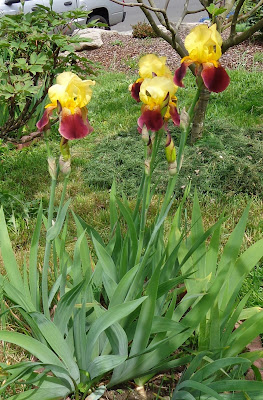 |
| Spring Seed Planting |
These are the seeds I planted in the past week.
Alyssum and
Bonanza Mix Marigolds in the tomato bed. They sprouted during the rains of the last week. Also planted alyssum seeds in the border of the new iris raised bed.
Clemson Spineless Okra - Also in the tomato bed. Clemson Spineless was introduced by Clemson University in 1939, 50-64 days. That's in an ideal hot climate - possibly 2 or 3 months here if it bears at all. After one week of rain, I also saw sprouts. I read that they require soaking and heat. So I started some today after soaking with 2 changes of water, for several hours. I also read Okra doesn't respond well to transplanting. The seeds I planted today I planted in newspaper-lined containers to reduce transplant shock.
Swiss Chard - in empty squares of the iris bed I set up last weekend. It will be mid to late summer before I add the irises in those spaces. I don't want to leave it with bare soil. Space is at a premium.
Petite Yellow Watermelon ( 65-80 days) and
Blacktail Mountain Watermelon (65-75 days) - Haven't tried watermelons here. Starting in containers, today. Then into raised bed. Cleared some space in the raised bed, from winter vegetables. Some of those didn't do well, others have been harvested - radishes, greens.
Minnesota Midget Canteloupe (60-75 days). Haven't tried these either. These are a small melon, 4 inches, and the vines are 3 feet long. May plant them in containers, not sure yet. Also starting in containers, today.
Japanese Soyu Burpless Cucumber (65 days). Starting in containers today. Will find a place for them.
Asparagus Pea (60-75 days). Starting in containers. Will need to fine a place for them too.
Parisian Carrot (55 days) and
Red Cored Chantenay Carrot. (70 Days). Also in the new iris bed, for the same reason.
Also some
cleome seeds for Ning's meadow.
Also the last of the
sweet potatoes. One week ago, I discovered what looked like near dead sweet potato starts in the mailbox. They were there for the weekend. I cleaned them up and planted the best looking ones in a half barrel. These sweet potatoes were described as an early variety, good for the North. The remaining set I placed in a glass of water, with daily water changes. They also look better, grew new roots, so I planted them today.






















